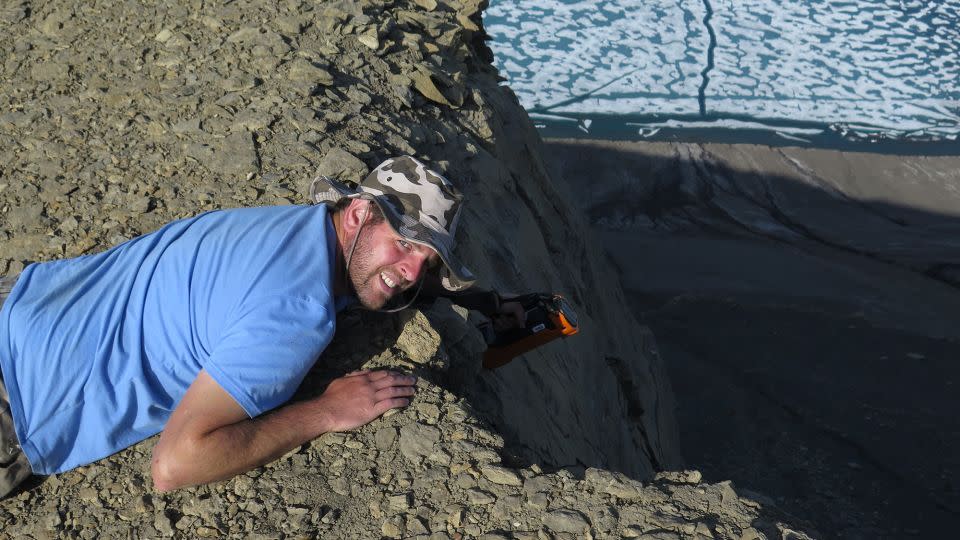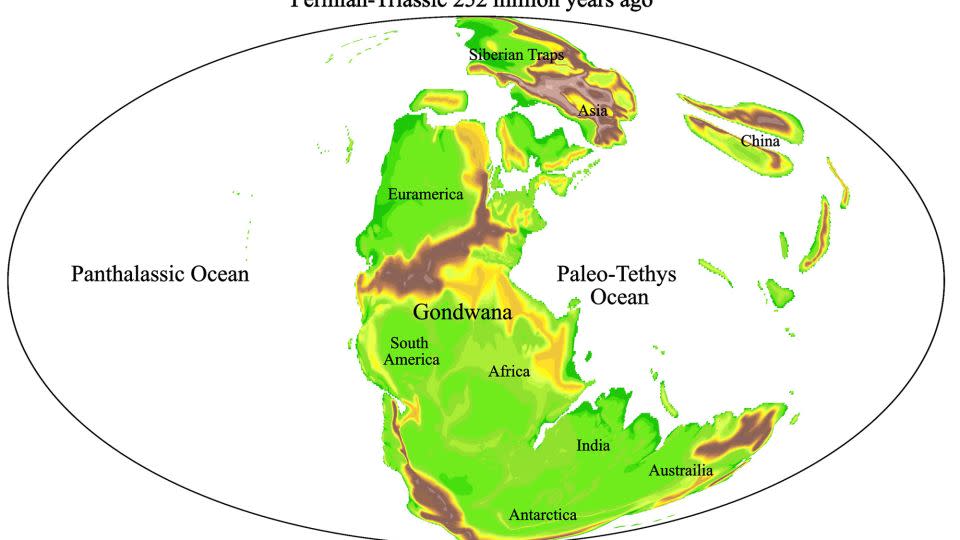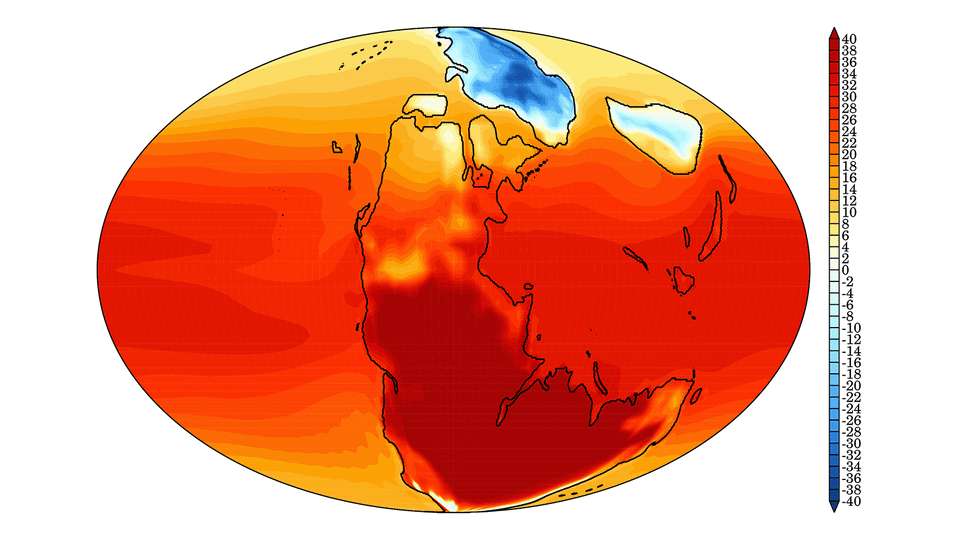Sign up for CNN’s Wonder Theory science newsletter. Explore the universe with news on fascinating discoveries, scientific advancements and more.
A cataclysm engulfed the planet some 252 million years ago, wiping out more than 90% of all life.
Known as the Great Dying, the mass extinction that ended the Permian geological period was the worst of the five global catastrophic events in Earth’s history, more devastating, than the one caused by a giant asteroid that spelled doom for the dinosaurs.
The most credible explanation put forward to date has been that carbon dioxide released by volcanic activity in a region known as the Siberian Traps caused a sudden warming of the planet. The emissions in the vast area in what’s now Russia that was about the size of Australiar esulted in higher temperatures, acid rain and ocean acidification.
However, a mega El Niño effect — similar but more intense and prolonged than how the climate phenomenon is experienced today — could have played a pivotal role, according to new research published Thursday in the journal Science.
“What we’re showing is that it was a climate-based extinction crisis. It wasn’t just the warming, it’s how the climate responded,” said study coauthor Paul Wignall, a professor of paleoenvironments at the University of Leeds in the United Kingdom.
“If the conditions were bad but constant,life could have evolved to cope with it. But the fact is, it kept lurching from one extreme to the other over the decades.”
The research team built a computer model of the global climate during the close of the Permian Period that suggested that as global temperatures rose, the El Niño events, a climate pattern that originates in the Pacific Ocean but affects weather all over the world, grew in magnitude and length.
The phenomenon turbocharged temperatures and resulted in alternating periods of flooding and scorching drought that would have unleashed wildfires, devastating all manner of species across the globe over a period of around 100,000 years.

El Niño events on a massive scale
Today, an El Niño event, which affects wind patterns and ocean currents, typically lasts between nine and 18 months and occurs every two to seven years. Alex Farnsworth, a senior research associate at the UK’s University of Bristol and the study’s joint lead author, said that during the warmest phases of the extinction event an El Niño episode would have lasted 10 years.
The El Niño of 252 million years ago would have originated in the Panthalassic Ocean, a body of water much larger than today’s Pacific that could hold more heat, which in turn would have strengthened and sustained El Niño effects.
He added that volcanic activity remained a major factor but wasn’t sufficient on its own to explain the scale of the biological catastrophe that unfolded. The planet had experienced similar episodes earlier but they hadn’t triggered a mass extinction.
“It’s volcanism that was the main culprit here, but it had a feedback mechanism on ocean dynamics that led to these much stronger El Niños starting to develop and then (the two things) play in concert,” Wignall said.
A prolonged and intense El Niño also explained why extinctions had begun on land before they occurred in the ocean, the study said.
“Whilst the oceans were initially shielded from the temperature rises, the mega-El Nino’s caused temperatures on land to exceed most species thermal tolerances at rates so rapid that they could not adapt in time,” co-lead author Yadong Sun, a researcher at China University of Geosciences in Wuhan, said in a news release.
“Only species that could migrate quickly could survive, and there weren’t many plants or animals that could do that.”


A key reason the end-Permian extinction was so dire was because the mega El Niños created incredibly warm conditions in the tropics, which spread quickly to higher latitudes, resulting in the loss of most vegetation and its ability to remove carbon dioxide from the atmosphere.
“You lose all trees at this time, which is amazing. Nothing would have been growing higher than your knees in the early Triassic,” Wignall said, referring to the geological era that followed the extinction event when the ecosystem began to recover.
Past changes in temperature can be determined in several ways — from plant and animal fossils, cores of sediment and ice, and, for more recent changes, tree rings and coral. This proxy data can be used to build computer models that help scientists reconstruct and understand what past conditions and climate systems were like.
Farnsworth said the team’s climate model, which took months to run multiple simulations, was better than its predecessors at piecing together what happened because of new, detailed temperature data gleaned from fossils of tiny eel-like creatures known as conodonts collected and analyzed over a long period. This data showed how temperature rose at different latitudes as the mass extinction unfolded.
The ratio of two different oxygen isotopes or variants in the fossilized tooth material of the conodonts, which were commonplace in the ocean at that time, was dependent on temperature, he added.
Alfio Alessandro Chiarenza, Royal Society Newton International Fellow at University College London’s department of Earth sciences, said it would now be interesting to find evidence in the fossil record of how organisms — including trilobites, early amphibians, reptile-like mammal ancestors and early crocodilians — were affected by the extinction, and which aspects of their biology were most severely impacted by these climatic upheavals.
“This study provides yet another example of how complex and interconnected climatic-environmental dynamics are and how such processes can radically affect ecological balance — a serious warning in light of our current ecological crisis,” said Chiarenza, who wasn’t involved in the study.
Resonance with today’s climate crisis
Some researchers today think we’re in the middle of a sixth mass extinction and that the end-Permian extinction may hold lessons for the current climate crisis.
El Niño events today are known to cause coral bleaching and mass mortality of fish, the study noted, but the ecological impact and future trajectory of El Niño events in a warming climate are unknown.


However, Wignall said the world 252 million years ago was geographically a different place — home to a huge supercontinent called Pangea and a massive ocean, which may have made it more sensitive to the carbon dioxide expelled by supervolcanoes.
“The end-Permian is the biggest crisis in Earth’s history from life’s standpoint, but I don’t think we’ll ever get anywhere near those conditions again, because (Earth back then) was a really strange planet with a continent on one side and gigantic ocean on the other,” he said.
“The planet was really vulnerable at that time.”
For more CNN news and newsletters create an account at CNN.com
